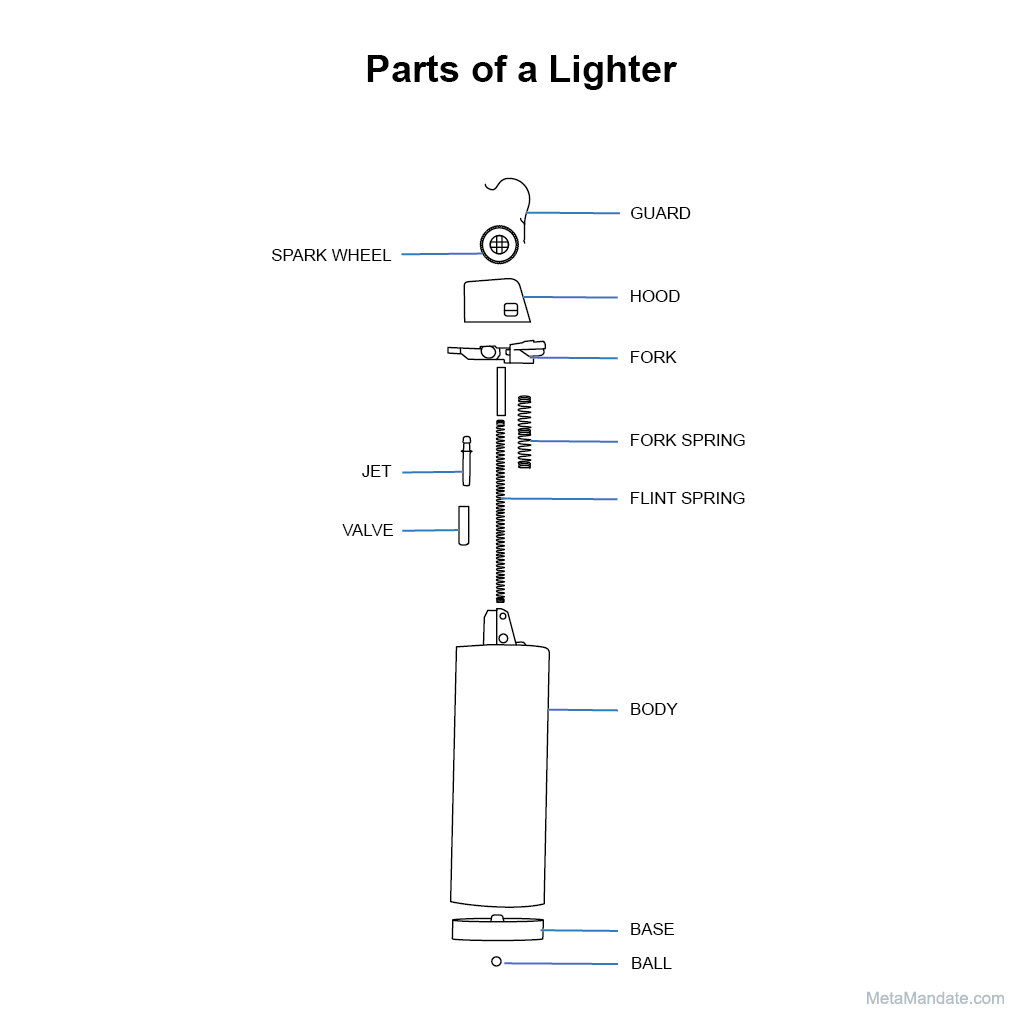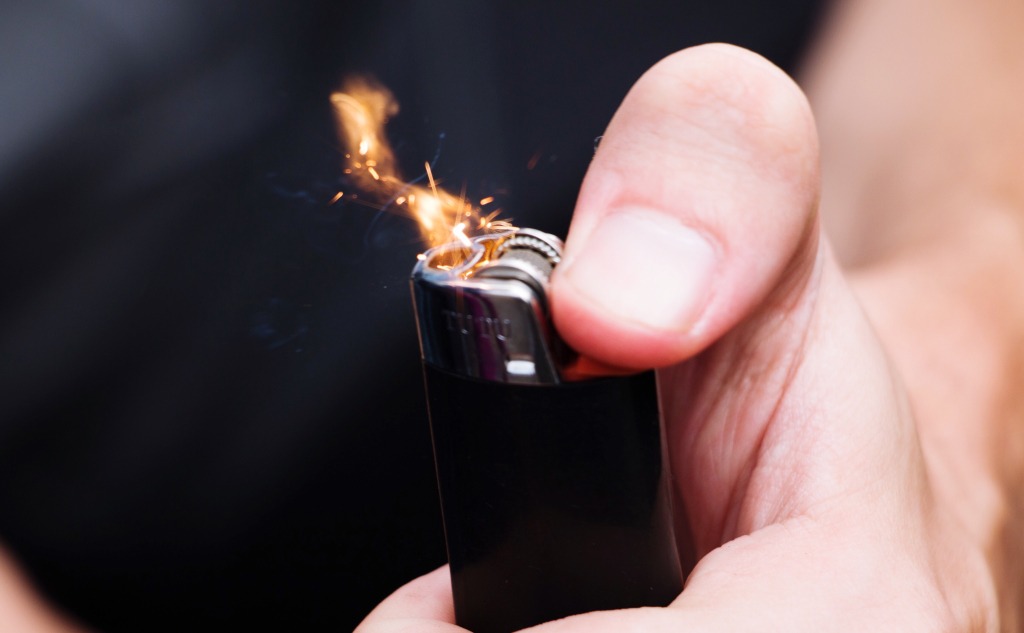Here are the 12 parts of a lighter:
- Guard
- Spark wheel
- Hood
- Fork
- Fork spring
- Jet
- Flint
- Flint spring
- Valve
- Body
- Base
- Ball
So if you want to learn all about the parts of a lighter, their names, and their functions, then this article is for you.
Keep reading!
Table of Contents
- #1 Guard
- #2 Spark Wheel
- #3 Hood
- #4 Fork
- #5 Fork Spring
- #6 Jet
- #7 Flint
- #8 Flint Spring
- #9 Valve
- #10 Body
- #11 Base
- #12 Ball

#1 Guard
Basically a guard is a flexible, deformable piece that covers the striking wheel.
In order to operate the lighter, the user must press hard enough to depress the guard before rotating the striking wheel.
The main purpose of a guard is to make a lighter child resistant.
Child-resistant lighters are lighters that have been modified in a way to make it difficult for children to operate.
Child-resistant lighters are not child-proof lighters. Child-resistant lighters cannot be operated by at least 85% of children under the age of 51 months.
Thus, up to 15% of children may still be able to operate such a lighter. Therefore, adults should always make sure that young children cannot gain access to lighters, even if they are child-resistant.
#2 Spark Wheel
The spark wheel is the part users are most acquainted with.
As the name suggests, the spark wheel is shaped like a small “wheel.” It’s commonly made of serrated hardened steel wire.
The flint rubs onto the wheel when spun with sufficient force and speed, thus creating a spark. The spark will then ignite the fuel within and produce the flame.
The spark wheel can either be covered by a plastic lever (AKA fork) or completely exposed depending on the lighter type.
Spark wheel lighters become hot to the touch when lit for a long time, which is why most people prefer lighters without the spark wheel exposed.
#3 Hood
Alongside heat protection, the hood serves several functions. One, it acts as a windshield by keeping the flame lit and protected from the wild.
Two, it controls the amount of air that touches the gas.
The height of the lighter’s flame can be modified by moving the tab located in the lower part of the hood. The greater the airflow, the bigger the flame.
The hood is made from heat-resistant metal like steel to prevent users from burning themselves while lighting the lighter.
#4 Fork
The fork controls the opening and closing of the gas coming from the lighter’s valve. When the fork is pushed down with enough pressure, a flame ignites.
Unless you’re using a collectible Zippo lighter, the flame will continue to burn until you release the fork. Releasing the fork closes the valve and, consequently, the gas flow.
#5 Fork Spring
The fork spring controls the movement of the fork, pushing it back up when released.
The spring’s wire is usually made of heat-resistant chromium-silicon steel.
Although fairly durable, the coils of the spring do get damaged over time. When damaged, the lighter is rendered useless.
The springs on collectible lighters can be replaced with newer springs, but with cheap lighters, you’re better off buying a new one.
#6 Jet
Located right underneath the hood, the jet is connected to the valve of the gas reservoir.
The jet, combined with the fork and fork spring, controls the strength and direction of the flame. This allows you to use the lighter to light a candle or cigarette without cutting the flame.
Before distribution, the jet seal subassembly is quality checked by a camera vision system to guarantee its safety.
#7 Flint
In disposable lighters, the flint is generally made of a pyrophoric alloy known as ferrocerium.
Although the exact composition varies from manufacturer to manufacturer, the ferrocerium consists of cerium (~50%), lanthanum (~25%), and iron (~20%). The other 5% is a mix of praseodymium, magnesium, and neodymium.
When the spark wheel is spun, it rubs against the flint and creates an internal spark, which will then ignite the fuel within.
Since the flint is composed of a mixture of chemical materials, it wears over time. It should be fed continuously through the eyelet to produce a spark.
In most cases, the flint in a disposable lighter can ignite up to 3,000 times.
#8 Flint Spring
The flint spring is located right underneath the flight. It’s typically made of a combination of steel and brass.
The steel withstands tear while the brass feeds new material when the older one wears out.
The brass, which is always in direct contact with the flint, helps ignite the spark when the spark wheel rubs against the flint. When the spark wheel is struck, a valve opens to let the gas fluid run through.
The flint spring keeps the flint in place whenever pressure is applied to the spark wheel. It basically feeds the flint onto the spark wheel as the flint wears.
#9 Valve
The valve is one of the most crucial elements of a lighter, as it regulates fuel flow and releases a constant level of fuel at a predetermined level.
The spring forces the valve open, which subsequently releases flammable fluid from the reservoir when you trigger the fork.
The wheel, fork, and flint work together as a single mechanism to ignite the flame. Without the valve, none of the mentioned components will work as they should.
Since the valve regulates fuel flow, it’s the part that needs to be replaced when the gas is leaking.
When replacing the valve, the fluid needs to be fully drained for safety purposes. Then, locate the valve stem by holding the lighter upside down and testing the spark wheel several times.
Once located, you’ll have to unscrew the value with an eyeglass screwdriver.
The valve should fall off automatically, allowing you to replace it with a new one.
#10 Body
The housing that holds everything together is called the body. It’s usually made of plastic, but some lighters, like collectible Zippo lighters, are made of brass or brushed chrome. Since the latter is harder to break, they tend to be more expensive.
The body, the base, and the seal ball make up the lighter’s gas reservoir.
#11 Base
The base locks the fluid inside the lighter’s body. If you want to refill the gas reservoir, you’ll have to remove the base to gain access.
Keep in mind that the base—which is usually made of plastic—isn’t as durable as the body itself. Therefore, you should always keep it away from sharp objects to prevent it from being punctured.
Also, make sure it isn’t exposed to high temperatures or flame to prevent the reservoir from exploding.
#12 Ball
At the very end of the lighter, you’ll find a small ball. This ball seals the gas reservoir after it’s filled.
The ball must be properly sealed to prevent gas leakage.
